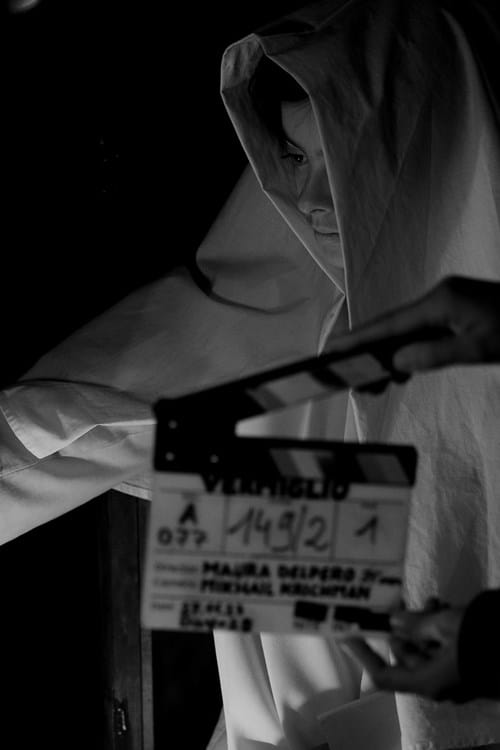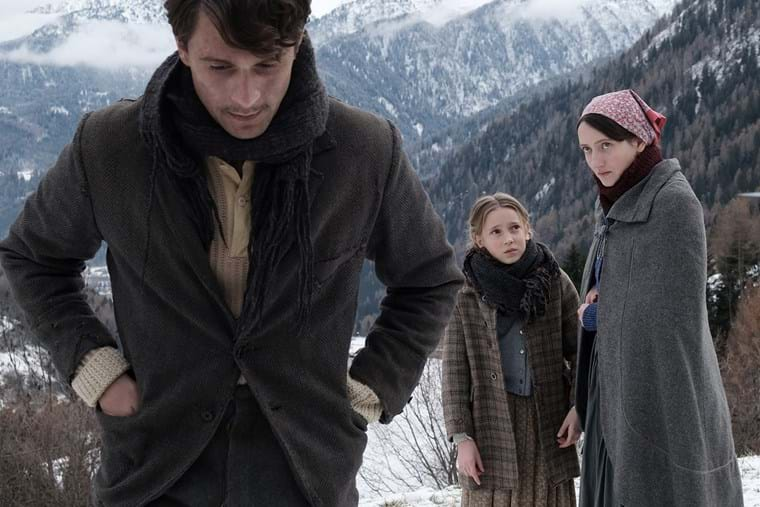The former pilgrims’ hostel St. Florian near Laag/Laghetti in the municipality of Neumarkt/Egna is one of the locations where Bolzano/Bozen-born director Maura Delpero’s new film is being shot. Vermiglio o la sposa di montagna tells a story set apart from the fronts of the Second World War that is both shocking and touching.
Far from the next residential area in the middle of the woods, the former hostel which used to shelter pilgrims on their way to Rome seems like a haunted, enchanted place. Producer Francesca Andreoli walks up a creaking flight of wooden stairs to the first floor of the “Klösterle”, the “little monastery”—the affectionate moniker the locals have bestowed on the St. Florian hostel. It is dark up here. The tiny windows barely allow in any light. On this cold November day, the cold seeps in relentlessly through the old brickwork. Boxes full of dolls and baby clothes are scattered everywhere; a candlestick; some standing microphones. A baby is being breastfed in a corner; some crew members are sipping tea from mugs.
“Silenzio!” The commanding tone of a woman’s voice makes everyone in the room hold their breath. A small monitor shows the goings-on in the next room. “Il monastero”, is Francesca Andreoli’s whispered explanation. The monitor shows an unfurnished room. Several small latticed bedsteads are lined up by the window. A nun dressed all in white enters the frame, carefully walks over to one of the baby beds, a baby wrapped in blankets in her arms. Suddenly a scream pierces the air. Turmoil ensues. “Stooop!” It looks like somebody was not in the mood for the camera right now. Other babies begin to cry now, too. Their mothers rush to their beds to calm them down. They are all locals who were hired for the morning. Ten minutes later, the shooting can continue. There will be several more attempts necessary this morning before the scene with the nun and her small niece Antonia is a wrap. A quiet scene, and a memorable moment in the film. “A moment that goes deep”, says the producer.
A family and a touching story
Vermiglio o la sposa di montagna is set towards the end of the Second World War. The three sisters Ada, Flavia, and Lucia grow up in the small mountain village of Vermiglio in the Trentino area. While no longer children, they are still young and inexperienced. They form a sworn community in a family where other siblings exist—until the fateful year 1944, when everything changes and the story eventually takes us all the way to Sicily. Director Maura Delpero will not give away any further details of the plot as she takes a moment during a break in shooting to sit down for an interview. Vermiglio o la sposa di montagna is inspired by Delpero’s own family history. It is set in places that played a role in her father’s life and picks up on some elements from real life—her grandfather, for example, was the village teacher, just like the father in the film. “When my father died in 2019, I started remembering things I had heard about in stories”, says Maura Delpero. “I didn’t want this part of history to get lost, so I did some research. I didn’t plan for a film to come out of that. It came from my soul, a matter of the heart.”

Authentic locations
Most of the shooting is done in the Trentino region—on location in Vermiglio as well as the Tonale Pass—and in South Tyrol/Südtirol. Both the scenes set in the convent and those set in the Alpine hut, which was built in the building’s backyard for that purpose, are shot at the pilgrims’ hostel. Moreover, one room was transformed into a Sicilian landscape for a scene in which a sleeping Lucia dreams that she is in Sicily.
After having shot the documentary Nadea e Sveta and the drama Maternal, Maura Delpero has found South Tyrol to be the ideal shooting location. The production company Cinedora, which she manages together with Francesca Andreoli, Leonardo Guerra Seràgnoli, and Santiago Fondevila Sancet, is realising the film as a co-production with Charades Productions (France) and Versus (Belgium) as well as Rai Cinema. The film project has already won the ArteKino International Award and the Coprocity Award and is supported, among others, by the IDM Film Commission.
About 60 people are involved with the production. The actors are from Italy; some from the Trentino region, like Martina Scrinzi from Rovereto, who is playing Lucia. The 26-year-old actress has only done theatre work so far. It is her first feature film, “which is why it is a great challenge”. With the camera so close that it records every tiny facial expression, it is not enough to play a person the way you would on stage. “You’ve got to be the person.” Authenticity is also a matter of principle for the director. An expert was hired to make sure that the actors use the Trentino dialect correctly. Maura Delpero wants to recount every detail of the story and show what really happened back then, and how it happened. During her research she learned that her family’s story was not an individual case. War does not only happen on the front line. It also leaves a mark outside of the line of fire.
